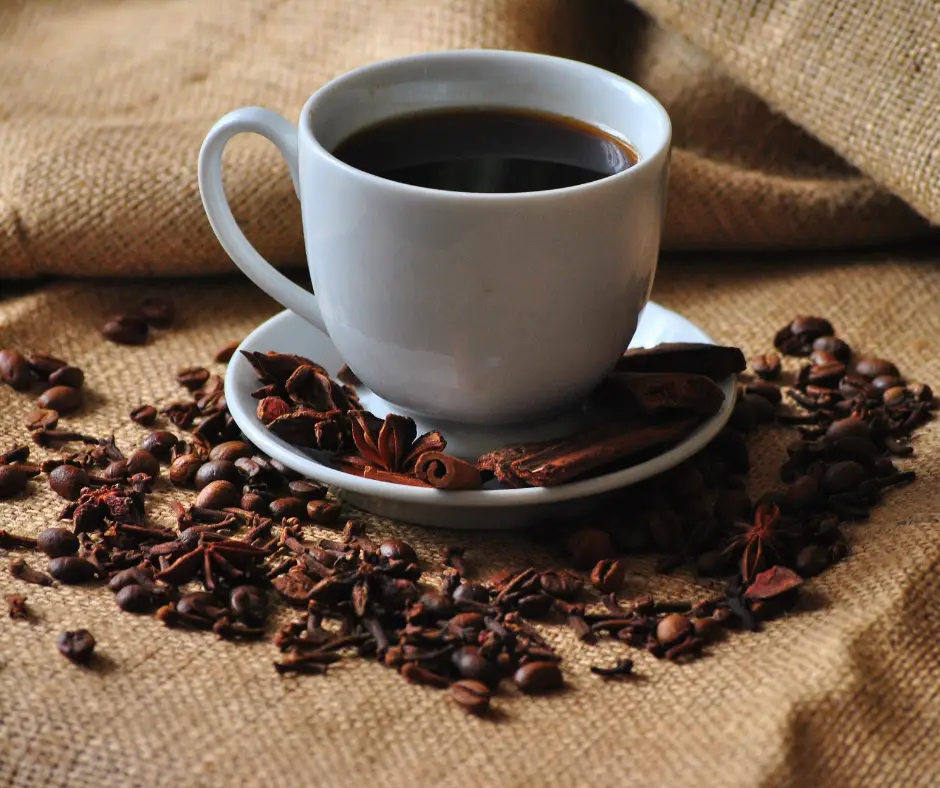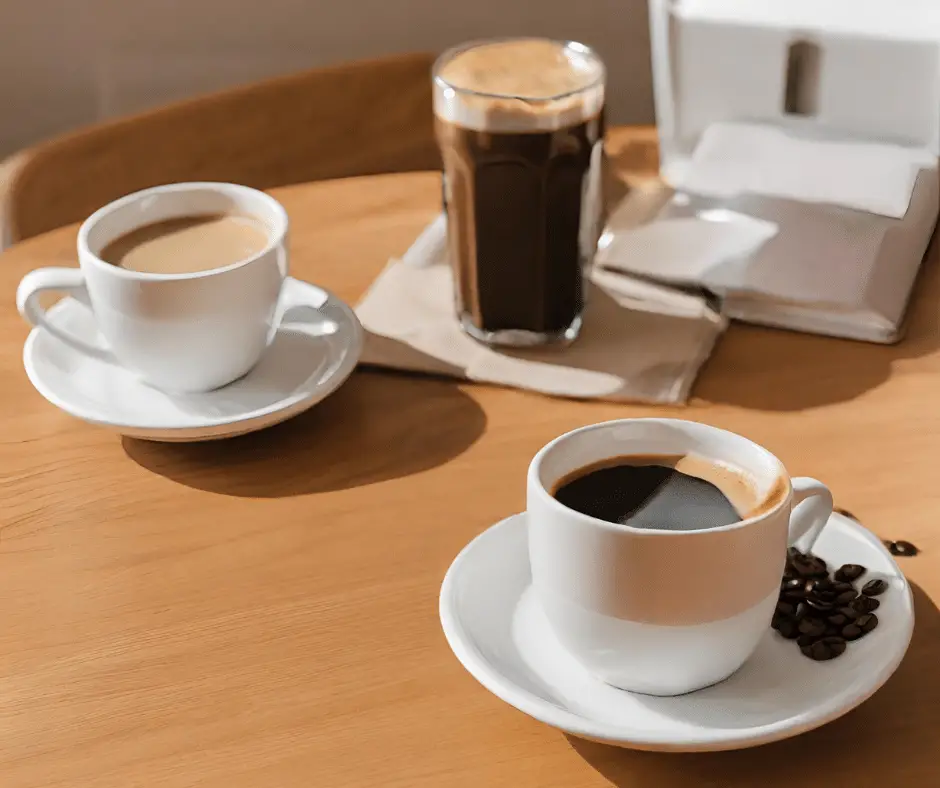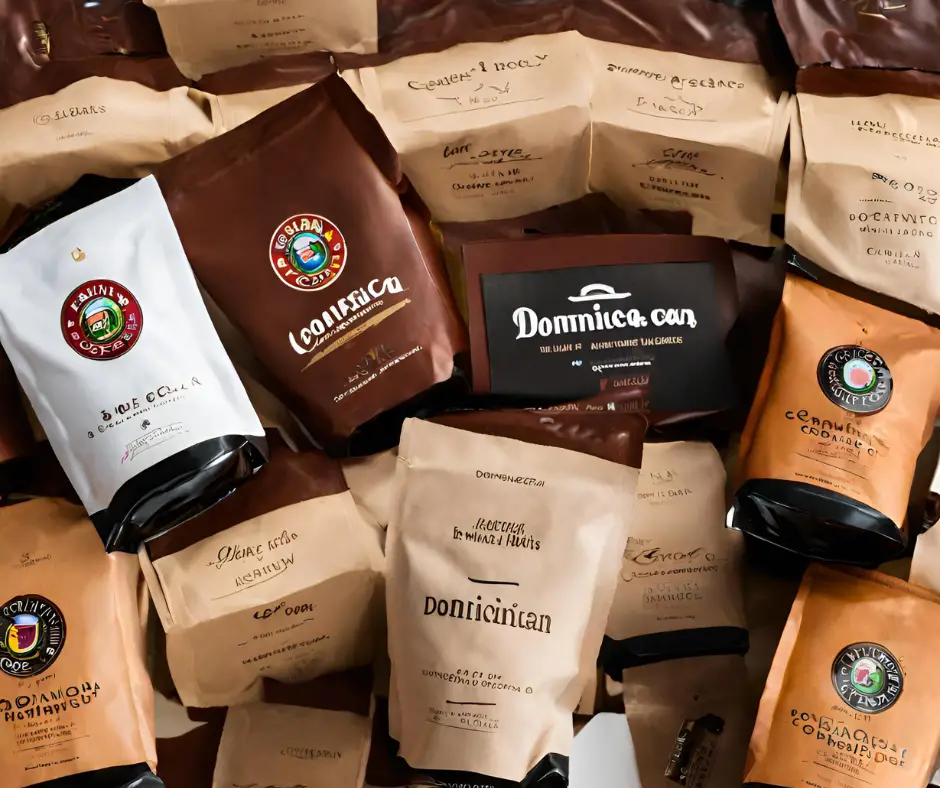It's important to understand what coffee is and the different types available. Coffee is a brewed drink made from roasted coffee beans, and it comes in various forms such as espresso, cappuccino, and americano. Each type of coffee has its own unique flavor profile and preparation method.
When it comes to the calorie content of coffee, black coffee is the lowest in calories. A standard cup of black coffee contains negligible calories, usually less than 5 calories per serving. The calorie content can be influenced by factors such as the size of the serving and the brewing method.
On the other hand, the calorie content of coffee can significantly increase when you add milk, sugar, or cream. These additions can add extra calories and impact the nutritional value of your coffee. For example, adding a splash of whole milk to your coffee can add around 10-20 calories, while a teaspoon of sugar can contribute an additional 15-20 calories. Similarly, using cream in your coffee can add around 50-60 calories, depending on the amount used.
Understanding the health impact of coffee calories is crucial, especially if you're watching your weight or managing your blood sugar levels. While black coffee without any additions is low in calories and can be part of a healthy diet, the extra calories from milk, sugar, or cream can contribute to weight gain if consumed in excess. coffee calories from sugar can affect blood sugar levels, especially for individuals with diabetes.
If you're looking to reduce your calorie intake from coffee, there are some simple tips you can follow. Opt for low-fat milk or plant-based alternatives instead of full-fat milk, choose natural sweeteners like stevia or honey instead of refined sugar, and consider reducing the amount of cream or sweeteners you add to your coffee.
By understanding the calorie content of coffee and making mindful choices, you can still enjoy your daily cup of coffee while managing your calorie intake and overall health.
Key takeaway:
- Coffee calories can vary depending on the type and serving size: Factors such as the type of coffee and serving size can affect the calorie content of coffee.
- Calories in coffee with additions: Adding milk, sugar, or cream to coffee can significantly increase its calorie content.
- Moderation is key for health impact: While coffee calories alone may not directly contribute to weight gain or affect blood sugar levels, excessive intake of high-calorie coffee drinks can have health implications.
What is Coffee?
Coffee, more than just a beverage, holds a world of flavors and aromas waiting to be explored. In this section, we'll dive into the realm of coffee and unravel its many dimensions. Discover the diverse types of coffee that exist, each offering a unique experience and taste sensation. From robust espresso to smooth latte, get ready to embark on a journey through the rich tapestry of flavors that coffee has to offer. Buckle up, coffee lovers, and get ready to savor every sip.
Types of Coffee
| Type | Description | Examples |
|---|---|---|
| 1. Espresso | Strong and concentrated coffee made by forcing steam through finely ground coffee beans | Double Espresso, Ristretto |
| 2. Americano | Diluted version of espresso, created by adding hot water to the espresso shot | Long Black, Lungo |
| 3. Cappuccino | Classic Italian coffee made with equal parts espresso, steamed milk, and frothed milk | Double Cappuccino, Wet Cappuccino |
| 4. Latte | Coffee made by combining espresso and steamed milk, topped with a small amount of frothed milk | Café Latte, Mocha Latte |
| 5. Macchiato | Espresso shot “marked” with a splash of milk or foam | Espresso Macchiato, Caramel Macchiato |
| 6. Flat White | Creamy, velvety coffee made with espresso and microfoam milk | Traditional Flat White, Almond Milk Flat White |
| 7. Mocha | Combination of espresso, chocolate syrup, and steamed milk, topped with whipped cream and chocolate shavings | Dark Chocolate Mocha, White Chocolate Mocha |
| 8. Frappuccino | Blended coffee-based beverage with ice, flavored syrups, milk, and often topped with whipped cream | Caramel Frappuccino, Java Chip Frappuccino |
Whether you prefer a strong espresso or a creamy latte, there are various types of coffee to cater to every taste. Here is a list of some popular types:
– Espresso: Made with finely ground coffee beans and steam forced through them, resulting in a strong and intense flavor. Examples include double espresso and ristretto.
– Americano: An espresso shot diluted with hot water, creating a milder taste. Variations include long black and lungo.
– Cappuccino: Equal parts espresso, steamed milk, and frothed milk, creating a classic Italian coffee. Variations include double cappuccino and wet cappuccino.
– Latte: Combination of espresso, steamed milk, and a small amount of frothed milk. Popular variations include café latte and mocha latte.
– Macchiato: Espresso shot “marked” with a splash of milk or foam. Common examples include espresso macchiato and caramel macchiato.
– Flat White: Creamy and velvety coffee made with espresso and microfoam milk. Popular choices include traditional flat white and almond milk flat white.
– Mocha: Combination of espresso, chocolate syrup, steamed milk, whipped cream, and chocolate shavings for a rich and indulgent drink. Variations include dark chocolate mocha and white chocolate mocha.
– Frappuccino: Blended coffee-based beverage with ice, flavored syrups, milk, and whipped cream. Popular examples include caramel frappuccino and Java Chip frappuccino.
With such a diverse range of coffee types available, there is something to suit every coffee lover's preferences and cravings.
Calories in Black Coffee
If you're curious about the calorie content in your favorite beverage, then let's dive into the world of black coffee. In this section, we'll explore the factors that can influence the calorie content of black coffee and uncover the different serving sizes and their corresponding calorie counts. So grab your mug and get ready to uncover the facts behind the calories in black coffee.
Factors Affecting Calorie Content
- Type of coffee beans: Different coffee bean varieties can affect the calorie content due to varying levels of oils and sugars.
- Roasting level: Lighter roasts have slightly higher calorie content compared to darker roasts.
- Brewing method: Espresso-based drinks like lattes and cappuccinos have higher calorie content than plain black coffee.
- Additions: Milk, sugar, and cream added to coffee significantly increase the calorie content due to added fats, sugars, and carbohydrates.
- Serving size: Larger servings of coffee naturally have more calories than smaller servings.
- Sweeteners: The type and amount of sweeteners used impact the calorie content. Artificial sweeteners or sugar substitutes may have fewer calories than regular sugar.
- Creamers: Different types of creamers, including regular cream, flavored creamers, or non-dairy alternatives, have varying calorie content.
- Syrups and flavorings: Adding syrups and flavorings to coffee increases the calorie content due to added sugars.
These factors should be considered when analyzing the calorie content of coffee and making choices aligning with personal dietary goals and preferences.
Calories in Different Serving Sizes
Here is a table showing the calories in different serving sizes of coffee:
| Serving Size | Calories |
| 8 oz (Regular Cup) | 2 |
| 12 oz (Tall Cup) | 3 |
| 16 oz (Grande Cup) | 4 |
| 20 oz (Venti Cup) | 5 |
The calories in coffee vary depending on the serving size. An 8 oz cup has 2 calories, a 12 oz cup has 3 calories, a 16 oz cup has 4 calories, and a 20 oz cup has 5 calories.
Note that these calorie counts are for black coffee without any additions. Adding milk, sugar, or cream to your coffee increases the calorie content. For example, adding a tablespoon of whole milk adds approximately 9 calories, a teaspoon of sugar adds 16 calories, and a tablespoon of cream adds 52 calories.
When watching your calorie intake, consider the serving size of your coffee, especially if you drink larger cups or add extras. Opt for smaller serving sizes or choose lower-calorie additives like skim milk or a zero-calorie sweetener to reduce the overall calorie content.
Fact: The average American consumes about three cups of coffee per day. Considering the calories in different serving sizes can have a significant impact on daily calorie intake.
Calories in Coffee with Additions
Did you know that your favorite cup of coffee could be sneaking in some extra calories? In this section, we'll explore the calorie content of different coffee additions. Whether it's milk, sugar, or cream, each sub-section will reveal how these ingredients can affect the overall calorie count of your beloved morning brew. Get ready to discover just how much those little extras can add up and make informed choices for your daily coffee fix.
Calories in Coffee with Milk
When it comes to the calories in coffee with milk, it's important to consider the serving size and the type of milk you use. The table below provides an approximate breakdown of the calories in different serving sizes of coffee with various types of milk: – Serving Size: 8 oz
| Calories with Skim Milk: 20 |
| Calories with 2% Milk: 30 |
| Calories with Whole Milk: 40 |
– Serving Size: 12 oz
| Calories with Skim Milk: 30 |
| Calories with 2% Milk: 45 |
| Calories with Whole Milk: 60 |
– Serving Size: 16 oz
| Calories with Skim Milk: 40 |
| Calories with 2% Milk: 60 |
| Calories with Whole Milk: 80 |
Please note that these calorie values are approximate and can vary depending on the brand of coffee and milk you choose. Keep in mind any additional additives like sugar or syrups, as they can increase the calorie content.
To reduce your calorie intake from coffee with milk, consider the following strategies:
- Opt for lower-fat milk options such as skim milk or 2% milk, as they have fewer calories than whole milk.
- Use smaller serving sizes to decrease your overall calorie intake.
- Avoid adding sugar or syrups, as they can significantly increase the calorie content.
- Explore alternative milk options like almond milk or oat milk, which have fewer calories compared to whole milk.
- Experiment with different brewing methods that enhance the natural flavor of coffee, reducing the need for milk or sweeteners.
By considering the serving size, type of milk, and any additional additives, you can still enjoy coffee with milk while managing your calorie intake.
Calories in Coffee with Sugar
Table: Calories in Coffee with Sugar
| Coffee Size | Amount of Sugar (g) | Calories |
|---|---|---|
| Small | 2 | 16 |
| Medium | 4 | 32 |
| Large | 8 | 64 |
Adding sugar to coffee increases the calorie content. The table above shows the calories in different sizes of coffee with added sugar.
Adding 2 grams of sugar to a small cup of coffee contributes 16 calories. For a larger cup, adding 8 grams of sugar results in 64 calories. The medium size falls in between, with 4 grams of sugar adding 32 calories.
It's important to note that these additional calories come from the sugar alone, excluding the calories from the coffee or other additions. If you're watching your calorie intake, consider the amount of sugar you add to your coffee.
Reducing sugar in your coffee can decrease your calorie intake. Gradually reduce the amount added until you can enjoy coffee with minimal or no sugar. Alternatively, try natural sweeteners like stevia or monk fruit to add sweetness without extra calories.
Mindfulness about the calories in coffee with sugar helps make informed choices about daily calorie intake. Adjusting sugar in coffee allows enjoyment of flavor without excess calories.
Remember that taste preferences and dietary needs vary, so finding the right balance is essential. Experiment with different levels of sweetness to find what works best for you.
Calories in Coffee with Cream
The calorie content in coffee with cream varies depending on the serving size and type of cream used. Here is a table showing the calories in different serving sizes of coffee with cream:
| Serving Size | Calories |
| 8 oz (240 ml) cup of coffee with 1 tbsp (15 ml) of half-and-half cream | 37 calories |
| 12 oz (360 ml) cup of coffee with 2 tbsp (30 ml) of half-and-half cream | 56 calories |
| 16 oz (480 ml) cup of coffee with 3 tbsp (45 ml) of half-and-half cream | 75 calories |
| 16 oz (480 ml) cup of coffee with 2 oz (60 ml) of heavy cream | 204 calories |
From the table, we can see that the calorie content in coffee with cream varies depending on the serving size and type of cream used. Choosing lighter options like half-and-half cream can help reduce calorie intake, while using heavy cream adds more calories to the coffee. When deciding on the amount of cream to add, it is important to consider individual dietary needs and goals.
Cream has been added to coffee for centuries to balance the bold flavor of the beverage and provide a creamy and smooth texture. Different types of cream, from half-and-half to heavy cream, have been used over time. Knowing the calorie content in coffee with cream allows individuals to make informed choices about their coffee preparation, taking into account their dietary preferences and goals. Whether it's a small splash of half-and-half or a more indulgent serving of heavy cream, adding cream to coffee can enhance the taste and provide a richer experience.
Health Impact of Coffee Calories
Health Impact of Coffee Calories
Coffee is a popular beverage enjoyed worldwide. While coffee is often associated with energy, it's important to consider its impact on health. Here are some key facts to keep in mind about coffee calories:
- Calorie content: Coffee itself is low in calories. A cup of black coffee has only 2 calories. The calorie content can increase depending on additives like sugar, milk, cream, or flavored syrups.
- Sugar and sweetness: Adding sugar to coffee significantly increases its calorie content. One teaspoon of sugar adds about 16 calories. Consider using natural sugar alternatives like stevia or monk fruit for sweetness with fewer calories and a smaller impact on blood sugar levels.
- Milk and cream: Adding milk or cream contributes to the calorie count. The type of milk or cream matters – whole milk has more calories than skim milk. Lighter options like half-and-half or non-dairy alternatives like almond milk can help reduce calories.
- Flavored syrups: Flavored syrups add sweetness and flavor but also come with added calories. Use them in moderation or choose sugar-free or low-calorie options.
- Health considerations: While coffee itself is low in calories, excessive consumption of high-calorie coffee beverages can lead to weight gain and potential health issues, especially if consumed frequently. Keep an eye on the overall calorie intake from coffee and consider healthier alternatives if weight management is a concern.
Fact: Studies have shown that excessive consumption of sugary coffee beverages, like flavored lattes or frappuccinos, increases the risk of obesity, type 2 diabetes, and other chronic health conditions. Choosing simpler coffee options can reduce the health impact of coffee calories.
By being mindful of the calorie content of your coffee and making informed choices regarding sugar, milk, cream, and other additions, you can enjoy your daily cup of coffee while maintaining a balanced and healthy lifestyle.
Can Coffee Calories Contribute to Weight Gain?
Coffee consumption is a popular morning ritual, but can coffee calories contribute to weight gain? Let's examine the facts:
– Calorie content: Black coffee is low in calories, with only 2 calories per 8-ounce cup. This is due to its simple preparation method of brewing coffee beans with water.
– Additions matter: The calorie content of coffee can significantly increase when adding milk, sugar, or cream. The amount and type of additions can add a few to several hundred calories.
– Calories from milk: Adding milk to coffee varies in calorie content based on the type and quantity used. For example, 1 tablespoon of whole milk adds approximately 9 calories, while the same amount of skim milk adds only 5 calories.
– Calories from sugar: Sugar added to coffee contributes to calorie intake. A teaspoon of sugar contains around 16 calories. If you prefer a sweeter coffee, the calorie content can quickly add up with multiple teaspoons or sugar substitutes.
While coffee itself is not a significant source of calories, the additions we choose can make a difference. Regularly consuming excessive calories from these additions can lead to weight gain over time. It's important to be mindful of the calories in the additions we use and consider healthier alternatives or moderation.
True story: Sarah used to drink her coffee with flavored creamer, which added significant calories to her daily intake. When she realized the impact on her weight, she switched to unsweetened almond milk and a small amount of natural sweetener. By making this simple change, Sarah reduced her daily calorie intake and gradually lost weight without giving up her beloved morning coffee.
Remember, the impact of coffee calories on weight gain depends on the choices we make with additions. By being conscious of our choices and opting for healthier alternatives when possible, we can still enjoy our daily coffee without worrying about its impact on our waistline.
Does Coffee Calories Affect Blood Sugar Levels?
When it comes to blood sugar levels, the question arises: does coffee calories affect blood sugar levels? The impact of coffee calories on blood sugar levels can be influenced by several factors. Let's explore some key points to consider:
-
Caffeine Content: Coffee contains caffeine, which has the potential to affect blood sugar levels. It is believed that caffeine may lower insulin sensitivity, leading to higher blood sugar levels in certain individuals.
-
Black Coffee: Plain black coffee, without any added milk or sugar, generally has a minimal impact on blood sugar levels. This is because black coffee has very few calories and almost no carbohydrates, which are the primary contributors to blood sugar spikes.
-
Coffee with Milk: Adding milk to your coffee increases its calorie and carbohydrate content. For individuals who are lactose intolerant or have difficulty digesting lactose, the lactose naturally present in milk can raise blood sugar levels.
-
Coffee with Sugar: Adding sugar to your coffee significantly raises its calorie and carbohydrate content. Consuming excessive amounts of sugar can cause rapid increases in blood sugar levels, especially for those with diabetes or insulin resistance.
-
Coffee with Cream: Similar to adding milk, using cream in your coffee adds calories and fat. While it may not directly impact blood sugar levels, consuming an excess of calories and fat can contribute to weight gain, thereby affecting insulin sensitivity and blood sugar control.
It is important to note that the effects of coffee calories on blood sugar levels can vary from person to person. Factors such as overall diet, lifestyle, and individual metabolism all play a role in how individuals respond to coffee consumption.
If you have concerns about your blood sugar levels, it is best to seek guidance from a healthcare professional or a registered dietitian. They can provide personalized advice based on your specific needs and goals.
Tips to Reduce Calorie Intake in Coffee
Tips to Reduce Calorie Intake in Coffee
When it comes to reducing calorie intake in coffee, follow these tips:
1. Stick to black coffee: Avoid added sugars, creams, and syrups to keep your coffee calorie-free.
2. Avoid flavored syrups: Opt for natural flavorings like cinnamon or cocoa powder instead of caramel, vanilla, or hazelnut syrups.
3. Use non-dairy milk alternatives: Choose almond milk or oat milk instead of whole milk or cream for lower calories. These alternatives are also suitable for those with lactose intolerance or following a vegan lifestyle.
4. Limit added sugars: Reduce the amount of sugar or switch to natural sweeteners like stevia or monk fruit extract.
5. Control portion sizes: Use smaller cups or mugs to limit coffee intake and reduce calorie consumption.
6. Choose light or medium roast coffee: These varieties have fewer calories compared to darker roasts.
7. Try cold brew or iced coffee: Refreshing alternatives with lower calories and no need for additional sweeteners or creams.
8. Watch out for specialty coffee beverages: Be cautious with lattes, mochas, or frappuccinos as they often have added sugars, creams, and syrups. Choose smaller sizes and request sugar-free or light versions.
By following these tips, you can reduce calorie intake in your coffee and make healthier choices. Remember to listen to your body's needs and practice moderation when consuming caffeine.
Some Facts About How Many Calories Are in Coffee:
- ✅ Black coffee and espresso have the fewest calories, with only 5 calories per 250ml or double shot. (Source: hanstrom.com)
- ✅ Mocha has the highest calorie content at 300 calories per 250ml, while latte has 200 calories and flat white has 150 calories. (Source: hanstrom.com)
- ✅ Americano with whole milk has 40 calories, while Americano with semi-skimmed milk has 30 calories, and Americano with skimmed milk has 20 calories. (Source: hanstrom.com)
- ✅ Caramel iced coffee contains 150-200 calories, with the majority of calories coming from milk, cream, and caramel. (Source: hanstrom.com)
- ✅ A coffee with whole milk and sugar contains around 70 calories, with the calorie content varying depending on the amount of sugar used. (Source: hanstrom.com)
Frequently Asked Questions
1. How many calories are in black coffee?
Black coffee has virtually zero calories.
2. What is the calorie content of a caramel iced coffee?
A caramel iced coffee can contain 150-200 calories, with the majority of calories coming from milk, cream, and caramel.
3. How many calories are in a latte?
A latte has approximately 200 calories.
4. Can adding flavored syrups to coffee increase the calorie count?
Yes, adding flavored syrups to coffee can increase the calorie count. Coffee syrups can contain 35-75 calories per pump.
5. Is cold brew coffee low in calories?
Yes, cold brew coffee is generally low in calories, especially when consumed without milk or sweeteners.
6. How can I subscribe to Mayo Clinic's free newsletter?
To subscribe to Mayo Clinic's free newsletter, you can sign up on their website by providing a valid email address.

.jpg)



